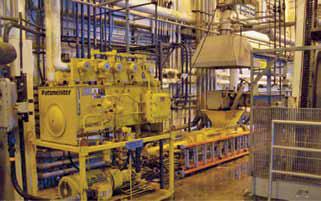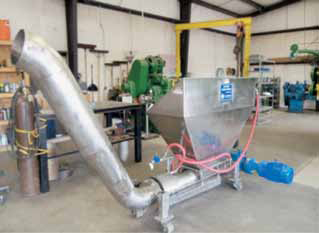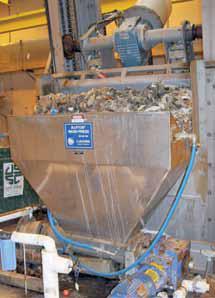Strange things can enter municipal wastewater processing plants. While the bulk of the volume is water, the main challenge is what is carried along with it. As the influent enters the plant, the first line of defense is coarse screens that separate large chunks of matter (rags, sand, paper and cardboard) that needs to be removed from the water stream.
Travelling screens continually bring the wet chunky matter into hoppers, and this is where problems begin. For a small plant, the screen would dump the screenings into a bin, which can then be periodically trucked away. However, it cannot be brought to fields as fertilizer or even to a landfill, because of the biological matter it contains. It must be burned or pre-treated before removal.
For larger, of more advanced plants, the screened matter is collected, washed, dewatered, moved, pressed, collected and disposed. This can be done in several ways, as this column describes.
Manual Disposal
Manual removal with a pitchfork may be employed to remove debris from the influent stream. However, working at a wastewater plant in this position, especially in the area of incoming raw sewage, will not likely keep a smile on your face for long.
Hydraulic Dewatering Press
A hydraulic dewatering press is more automated. The screened material falls into a hopper and is conveyed by a belt to a hydraulic ram. The hydraulic ram squeezes the material into a converging pipe, to dewater it, compact it and move it to removal hoppers.
These systems are complex and automated. They look nice on drawings but, unfortunately, are not so nice in the real world. With the 1,500 to 2,000 psi of hydraulic pressure required to overcome the motion and to reduce the volume of screening at the same time, the hydraulic auxiliary system (see Figure 1), is complex and large and requires specialized service. When they break, it usually means the end of automation, and someone should grab the pitchfork.
 |
| Figure 1. Hydraulic dewatering press can be a large, complex system |
Helical Screw
Another method for solid matter removal from wastewater is to use a hopper attached to a helical screw that is driven by a low-speed gearbox off the electric motor. The hopper feeds the screenings into a discharge pipe and then to a removal trash bin.
The system is simple with a relatively small control panel, which allows the screw to forward and reverse its rotation at a slow speed. This helps wash most of the bio matter from the screens. Then the matter is moved through a discharge pipe, dewatering and compressing the material at the same time.
The volume reduction of this type system can be about 20:1, which allows for the efficient and economical disposal of the waste by trucks to either landfills or for use as farm fertilizer, since biological matter is washed off during the processing (see Figure 2).
 |
| Figure 2. A hopper and discharge pipe |
These systems, too, occasionally have problems. When it happens, the picture does not look much prettier than the other two methods (see Figure 3). However, if the parameters of the system are understood and the equipment is sized correctly, these systems can provide good and reliable operation. Sizing considerations include:
The selection of the incoming hopper volume
- Speed of the helical screw
- Forward/reverse timing sequence
- Forward feed
- Control panel selection (to allow centralized, and/or local control by the operators)
 |
| Figure 3. A failed/cloggerd hopper |
After surveying many municipal plants, these options appear to be typical, although some additional variations exist. The key elements in all cases are post-installation service, modifications, adjustments and design upgrades depending on new conditions and changes within the plant. Proper design modifications and upgrades can make a difference between a troublesome system with operators reluctant to operate it and a trouble free and reliable designed-to-fit unit.

